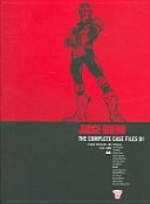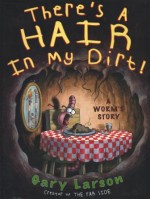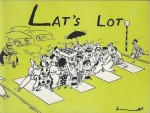
By John Wagner, Pat Mills, Carlos Ezquerra, Ian Gibson, Mike McMahon, Brian Bolland & various (Rebellion)
ISBN: 978-1-90426-579-0
Britain’s last great comic icon could be described as a combination of the other two, combining the futuristic milieu and thrills of Dan Dare with the terrifying anarchy and irreverent absurdity of Dennis the Menace. He’s also well on the way to becoming the longest-lasting adventure character in our admittedly meagre comics stable, having been continually published every week since February 1977 when he first appeared in the second issue of science-fiction anthology 2000AD – and now that the Dandy’s slated for cancellation, veterans Korky the Cat and Desperate Dan might one day be overtaken in the comedy stakes too…
However with at least 52 2000AD strips a year, annuals, specials, a newspaper strip (in the Daily Star and later The Metro), the Judge Dredd Megazine, numerous reprinted classic comics collections and even two rather appalling DC Comics spin-off titles, that adds up to a phenomenal amount of material, most of which is still happily in print.
Bolland by his own admission was an uneconomically slow artist and much of his Dredd work appeared as weekly portions of large epics with other artists handling other episodes,
Judicial Briefing: Dredd and his dystopian ultra-metropolis of Mega-City One – originally it was to be a 21st century New York – were created by a very talented committee including Pat Mills, Kelvin Gosnell, Carlos Ezquerra, Mike McMahon and others, but with the major contribution coming from legendary writer John Wagner, who has written the largest portion of the canon under his own and several pseudonyms.
Joe Dredd is a fanatically dedicated Judge in the super-city, where hundreds of millions of citizens idle away their days in a world where robots are cheaper and more efficient than humans, and jobs are both beloved pastime and treasured commodity. Boredom has reached epidemic proportions and almost everybody is just one askance glance away mental meltdown. Judges are peacekeepers who maintain order at all costs: investigating, taking action and trying all crimes and disturbances to the hard-won equilibrium of the constantly boiling melting pot. Justice is always immediate…
Dredd’s world is a polluted and precarious Future (In)Tense with all the key analogues for successful science fiction (as ever a social looking-glass for the times it’s created in) situated and sharply attuned to a Cold War Consumer Civilisation. The planet is divided into political camps with post-nuclear holocaust America locked in a slow death-struggle with the Sov Judges of the old Eastern Communist blocs. The Eastern lawmen are militaristic, oppressive and totalitarian – and that’s by the US Judges’ standards – so just imagine what they’re actually like…
They are necessary fascists in a world permanently on the edge of catastrophe, and sadly, what far too many readers never realise is that the strip is a gigantic satirical black comedy with oodles of outrageous, vicarious cathartic action.
Such was not the case when the super-cop debuted in 2000AD Prog (that’s issue number to you) #2 (March 5th 1977), stuck at the back of the new weekly comic in a tale finally scripted after much intensive re-hashing by Peter Harris and illustrated by Mike McMahon & Carlos Ezquerra.
The blazing, humourless, no-nonsense (all that would happily come later) action yarn introduced the bike-riding Sentinel of Order in the tale of brutal bandit Whitey whose savage crime spree was ended with ferocious efficiency before the thug was sentenced to Devil’s Island – a high-rise artificial plateau surrounded by the City’s constant stream of lethal, never-ending, high-speed traffic…
In Prog 3 he investigated The New You in a cunning thriller by Kelvin Gosnell & McMahon wherein a crafty crook tried to escape justice by popping into his local face-changing shop, whilst #4 saw the first appearance of the outcast mutants in The Brotherhood of Darkness (Malcolm Shaw & McMahon) when the ghastly pariahs invaded the megalopolis in search of slaves.
The first hints of humour began in Prog 5’s Krong by Shaw & Ezquerra, with the introduction of Dredd’s Italian cleaner Maria, wherein deranged horror film fan and hologram salesman Kevin O’Neill – yes it’s an in-joke – unleashed a giant mechanical gorilla on the city. The issue was the first of many to cover-feature old Stone Face…
Frankenstein 2 pitted Dredd against an audacious medical mastermind hijacking citizens to keep his rich aging clients in fresh, young organs, after which #7 saw ruthless reprobate Ringo’s gang of muggers flaunting their criminality in the very shadow of The Statue of Judgement until Dredd lowered the boom on them…
Charles Herring & Massimo Belardinelli produced the Antique Car Heist in #8, which first indicated that the super-cop’s face was hideously disfigured, when the Judge tracked down a murderous thief who stole an ancient petrol-burning vehicle, after which co-creator John Wagner returned in Prog 9 to begin his staggering run of tales with Robots, illustrated by veteran British science fiction artist Ron Turner, which set the scene for an ambitious mini-saga in #10-17. The gripping vignette was set at the Robot of the Year Show, and revealed the callous cruelty indulged in by citizens upon their mechanical slaves as a by-product of a violent blackmail threat by a disabled maniac in a mechanical-super chair…
Those casual injustices paved the way for Robot Wars (alternately illustrated over the weeks by Ezquerra, Turner, McMahon & Ian Gibson) wherein carpenter-robot Call-Me-Kenneth experienced a mechanical mind meltdown and became a human-hating steel Spartacus, leading a bloody revolution against the fleshy oppressors. The slaughter was widespread and terrible before the Judges regained control, helped in no small part by loyal, lisping Vending droid Walter the Wobot, who became at the epic’s end Dredd’s second live-in comedy foil…
With order restored a sequence of self-contained stories firmed up the vision of the crazed city. In Prog 18 Wagner & McMahon introduced the menace of mind-bending Brainblooms cultivated by a little old lady career criminal, Gerry Finley-Day & John Cooper described the galvanising effect of the Muggers Moon on Mega-City 1’s criminal class whilst Dredd demonstrated the inadvisability of being an uncooperative witness…
Wagner & McMahon introduced Dredd’s bizarre paid informant Max Normal in #20, whose latest tip ended the profitable career of The Comic Pusher, Finley-Day & Turner turned in a workmanlike thriller as the super-cop tackled a seasoned killer with a deadly new weapon in The Solar Sniper and Wagner & Gibson showed the draconian steps Dredd was prepared to take to bring in mutant assassin Mr Buzzz.
Prog 23 launched into all-out ironic satire mode with Finley-Day & McMahon’s Smoker’s Crime when Dredd trailed a killer with a bad nicotine habit to a noxious City Smokatorium, after which Malcolm Shaw, McMahon & Ezquerra revealed the uncanny secret of The Wreath Murders in #24. The next issue began the feature’s long tradition of spoofing TV and media fashions when Wagner & Gibson concocted a lethal illegal game show in You Bet Your Life whilst #26 exposed the sordid illusory joys and dangers of the Dream Palace (McMahon) and #27-28 offered some crucial background on the Judges themselves when Dredd visited The Academy of Law (Wagner & Gibson) to give Cadet Judge Giant his final practical exam. Of course for Dredd there were no half measures or easy going and the novice barely survived his graduation…
With the concluding part in #28, Dredd moved to second spot in 2000AD (behind brutally jingoistic thriller Invasion) and the next issue saw Pat Mills & Gibson tackle robot racism as Klan-analogue The Neon Knights brutalised the reformed and broken artificial citizenry until the Juggernaut Judge crushed them.
Mills then offered tantalising hints on Dredd’s origins in The Return of Rico! (McMahon) when a bitter criminal resurfaced after twenty years on the penal colony of Titan, looking for vengeance upon the Judge who had sentenced him. From his earliest days as a fresh-faced rookie, Joe Dredd had no time for corrupt lawmen – even if one were his own clone-brother…
Whitey escaped from Devil’s Island (Finley-Day & Gibson) in Prog 31, thanks to a cobbled-together device that turned off weather control, but didn’t get far before Dredd sent him back, whilst the fully automated skyscraper resort Komputel (Robert Flynn & McMahon) became a multi-story murder factory that only the City’s greatest Judge could counter before Wagner (frequently using the pseudonym John Howard) took sole control for a series of savage whacky escapades beginning with #33’s Walter’s Secret Job (Gibson) as the besotted droid was discovered moonlighting as a cabbie to buy pwesents for his beloved master.
McMahon and Gibson illustrated the two-part tale of Mutie the Pig: a flamboyant criminal who was also a bent Judge, and performed the same tag-team effort for The Troggies, a debased colony of ancient humans living under the city and preying on unwary citizens…
Something of a bogie man for wayward kids and exhausted parents, Dredd did himself no favours in Prog 38 when he burst in on Billy Jones (Gibson) and revealed a massive espionage plot utilising toys as surveillance tools, and tackled The Ape Gang in #39 (19th November 1977 and drawn by McMahon), seamlessly graduating to the lead spot whilst shutting down a turf war between augmented, educated, criminal anthropoids in the unruly district dubbed “the Jungleâ€â€¦
The Mega-City 5000 was an illegal and murderously bloody street race the Judges were determined to shut down, but the gripping action-illustration of the Bill Ward drawn first chapter was sadly overshadowed by hyper-realist rising star Brian Bolland, who began his legendary association with Dredd by concluding the mini-epic in blistering, captivating style in Prog 41.
From out of nowhere in a bold change of pace, Dredd was then seconded to the Moon for a six-month tour of duty in #42 to oversee the rambunctious, nigh-lawless colony set up by the unified efforts of three US Mega-Cities there. The place was as bonkers as Mega-City One and a good deal less civilised – a true Final Frontier town…
The extended epic began with Luna-1 by Wagner & Gibson, with Dredd and stowaway Walter almost shot down en route in a mysterious missile attack and then targeted by a suicide bomb robot before they could even unpack.
‘Showdown on Luna-1’ introduced permanent Deputy-Marshal Judge Tex from Texas-City whose jaded, laissez-faire attitudes got a good shaking up as Dredd demonstrated he was one lawman who wasn’t gong to coast by for the duration of his term in office. Hitting the dusty mean streets, Dredd began to clean up the wild boys in his town by outdrawing a mechanical Robo-Slinger and uncovering another assassination ploy. It seemed that reclusive mega-billionaire Mr. Moonie had a problem with the latest law on his lunar turf…
Whilst dispensing aggravating administrative edicts like a frustrated Solomon, Dredd chafed to hit the streets and do some real work in #44’s McMahon-limned ‘Red Christmas’. An opportunity arose when arrogant axe-murderer Geek Gorgon abducted Walter and demanded a showdown he lived to regret, whilst ’22nd Century Futsie!’ (Gibson) saw Moonie Fabrications clerk Arthur Goodworthy crack under the strain of over-work and go on a destructive binge with Dredd compelled to protect the Future-shocked father’s family from Moonie’s over-zealous security goons.
The plotline at last concluded in Prog 46 with ‘Meet Mr. Moonie’ (Gibson) as Dredd and Walter confronted the manipulative manufacturer and uncovered his horrific secret. The feature moved to the prestigious middle spot with this episode, allowing the artists to really open up and exploit the colour centre-spread, none more so than Bolland as seen in #47’s Land Race as Dredd officiated over a frantic scramble by colonists to secure newly opened plots of habitable territory. Of course there’s always someone who doesn’t want to share…
Ian Gibson then illustrated 2-part drama ‘The Oxygen Desert’ in #48-49, wherein veteran moon-rat Wild Butch Carmody defeats Dredd using his superior knowledge of the airless wastes beyond the airtight domes. Broken, the Judge quits and slides into despondency but all is not as it seems…
Prog 50 saw the debut of single-page comedy supplement Walter the Wobot: Fwiend of Dwedd – but more of that later – whilst the long-suffering Justice found himself knee-boot-deep in an international interplanetary crisis when ‘The First Lunar Olympics’ (Bolland) against a rival lunar colony controlled by the Machiavellian Judges of the Sov-Cities bloc escalated into assassination and a murderous politically-fuelled land grab. The issue was settled in ostensibly civilised manner with strictly controlled ‘War Games’ yet there was still a grievously high body-count by the time the moon-dust settled… This vicious swipe at contemporary sport’s politicisation was and still is bloody, brutal and bitingly funny…
Bolland also illustrated the sardonic saga of ruthless bandits who were up for a lethal laugh in #52’s The Face-Change Crimes, using morphing tech to change their appearances and rob at will until Dredd beat them at their own game, before Wagner & Gibson crafted a four-part mini-epic (Progs 53-56) wherein motor fanatic Dave Paton’s cybernetic, child-like pride-and-joy blew a fuse and terrorised the domed territory, slaughtering humans and even infiltrating Dredd’s own quarters before the Judge finally stopped Elvis, The Killer Car.
Bolland stunningly limned the savagely mordant saga of a gang of killer bandits who hijacked the moon’s air before themselves falling foul of The Oxygen Board in #57, but only managed the first two pages of 58’s Full Earth Crimes leaving Mike McMahon to complete the tale of regularly occurring chaos in the streets whenever the Big Blue Marble dominated the black sky above…
It was a fine and frantic note to end on as with ‘Return to Mega-City’ Dredd rotated back Earthside and business as unusual. Readers were probably baffled as to why the returned cop utterly ignored a plethora of crime and misdemeanours, but Wagner & McMahon provided the logical and perfect answer in a brilliant, action-packed set-up for the madcap dramas to come.
This first Case Files chronicle nominally concludes with Wagner & McMahon’s Firebug from Prog 60 as the ultimate lawgiver dealt with a crazed arsonist literally setting the city ablaze and discovered a venal motive to the apparent madness, but there’s still a wealth of superb bonus material to enjoy before we end this initial outing.
Kicking off proceedings and illustrated by Ezquerra is the controversial First Dredd strip which was bounced from 2000AD #1 and vigorously reworked – a fascinating glimpse of what the series might have been, followed by the first Walter the Wobot: Fwiend of Dwedd stwips (sowwy – couldn’t wesist!) from 2000AD Progs 50-58.
Scripted by Joe Collins, these madcap comedy shorts were an antidote to the savage and brutal action strips in the comic and served to set the scene for Dredd’s later full-on satirical lampoonery.
Tap Dancer was illustrated by Ian Gibson and dealt with an embarrassing plumbing emergency whilst Shoot Pool! (Gibson) saw the Wobot again taking the Judge’s instructions far too literally…
Brian Bolland came aboard to give full rein to his own outrageous sense of the absurd with the 5-part tale of Walter’s Brother, a bizarre tale of evil twins, a cunning frame-up and mugging that inevitably resulted in us learning all we ever needed to know about the insipidly faithful and annoying rust-bucket. Dredd then had to rescue the plastic poltroon from becoming a prate of the airwaves in Radio Walter before the star-struck servant found his 15 seconds of fame as the winner of rigged quiz-show Masterbrain, and this big, big book concludes with a trio of Dredd covers from Progs 10, 44 and 59, courtesy of artists Ezquerra, Kev O’Neill and McMahon.
Always mesmerising and beautifully drawn, these short punchy stories starring Britain’s most successful and iconic modern comics character are the constantly evolving narrative bedrock from which all the later successes of the Mirthless Moral Myrmidon derive. More importantly, they timeless classics that no real comic fan can ignore – and just for a change something that you can easily get your hungry hands on. Even my local library has copies of this masterpiece of British literature and popular culture…
© 1977, 1978, 2006 Rebellion A/S. All rights reserved. Judge Dredd & 2000AD are ® &™ Rebellion A/S.












